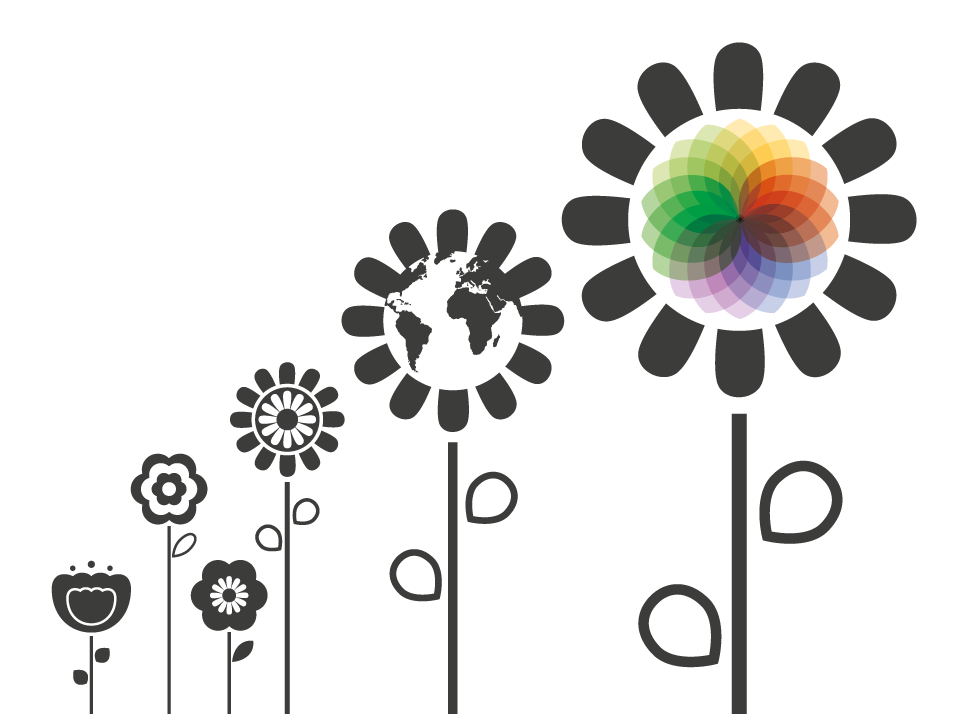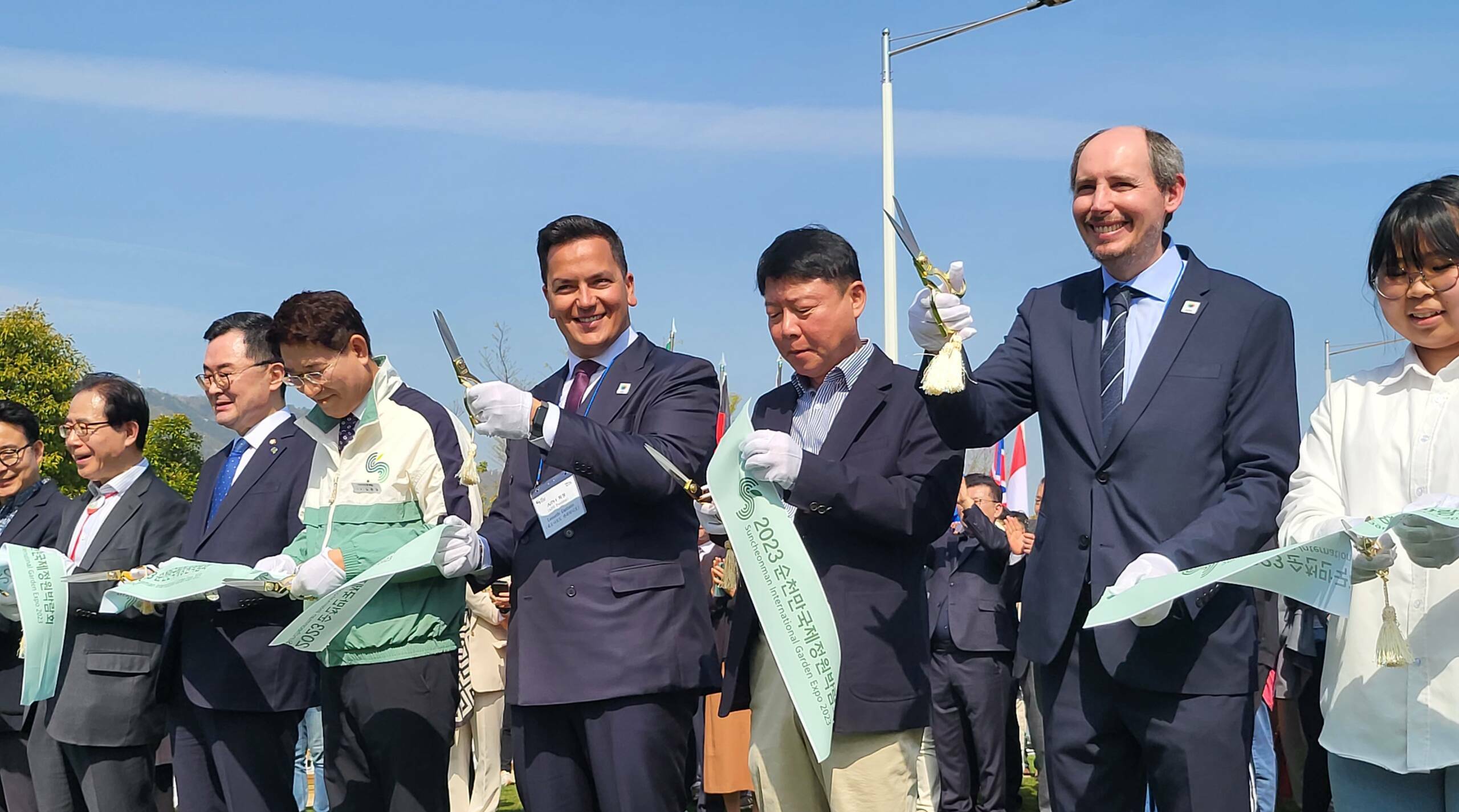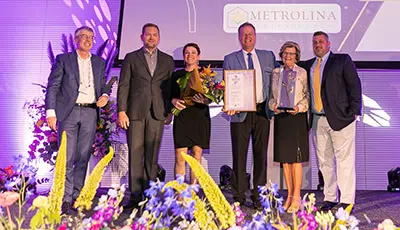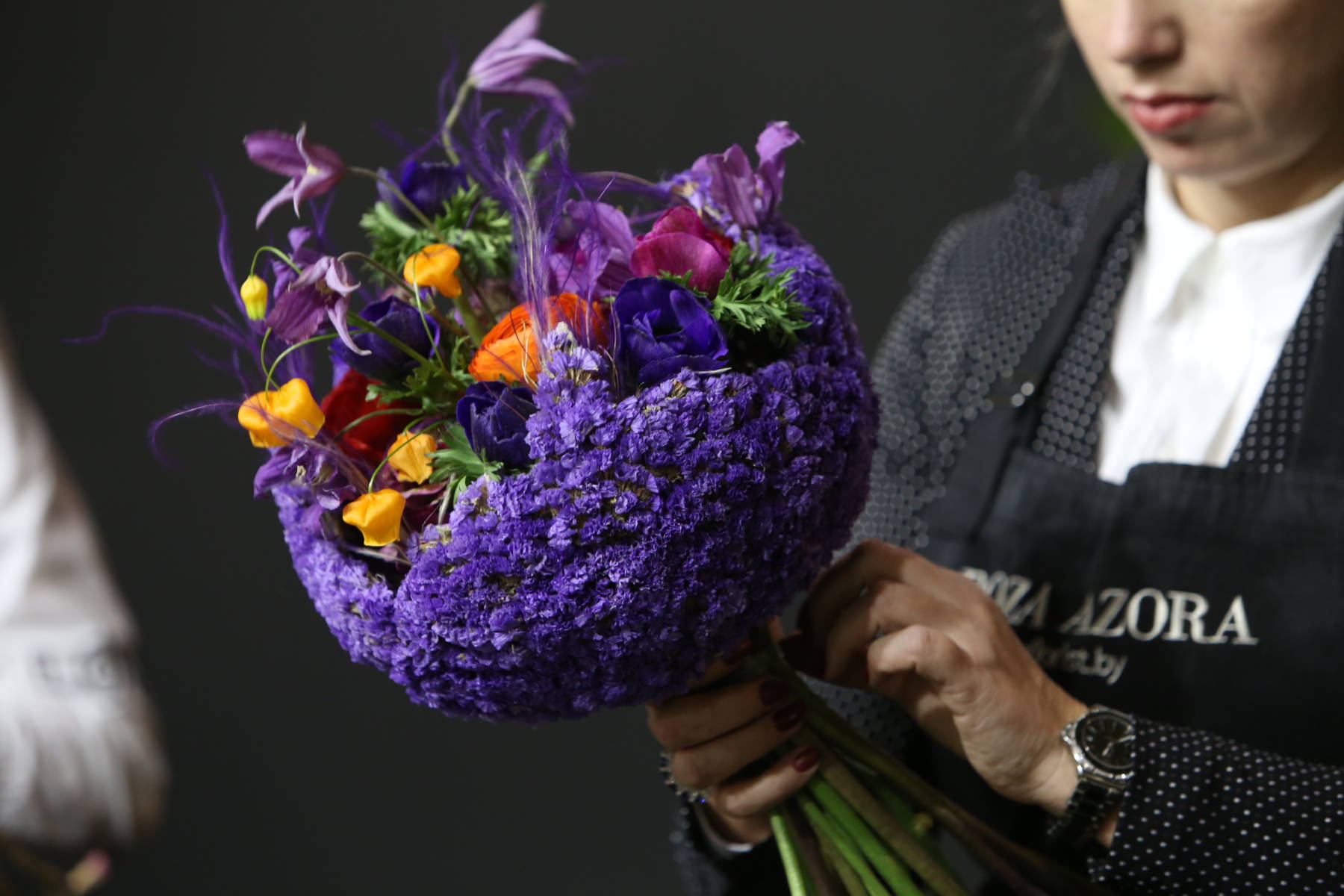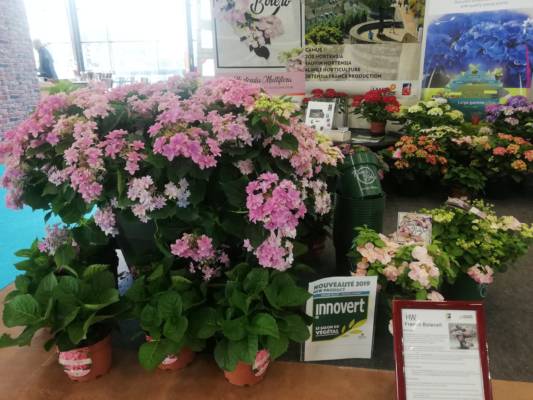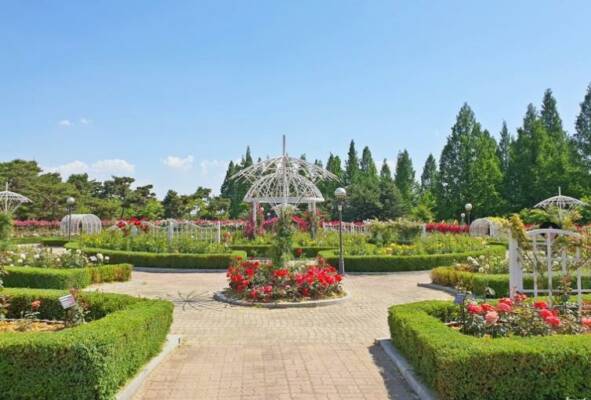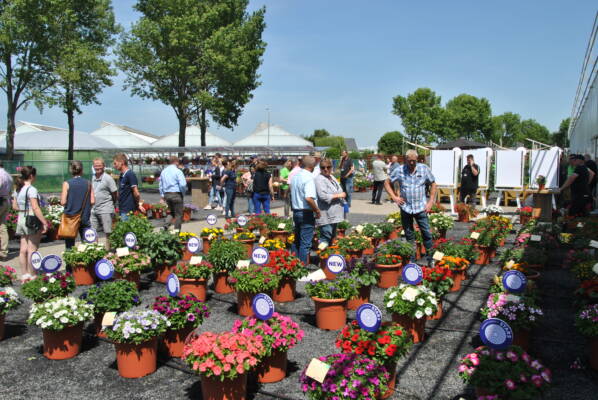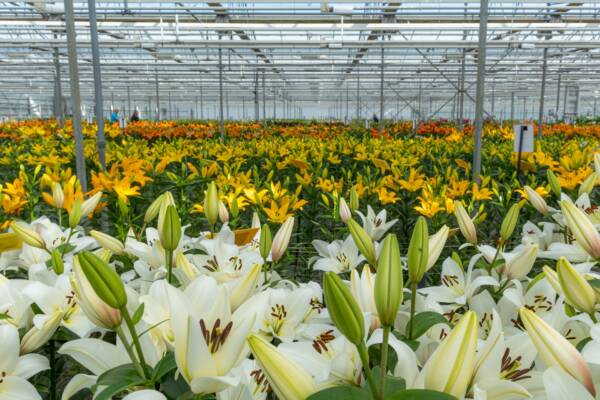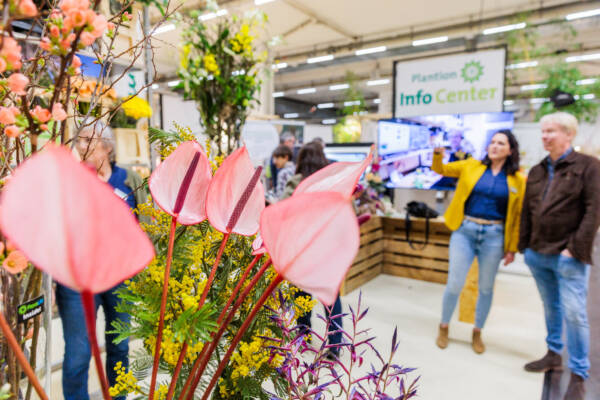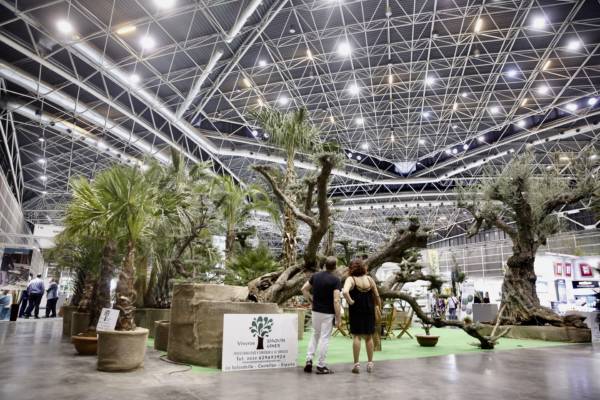MILAN, Italy: An upbeat mood, extremely mild winter weather, busy aisles and a grand opening. Hard not to be caught up in pre spring market euphoria following a visit to Italy’s rapidly expanding horticultural trade exhibition MyPlant &Garden (Milan, February 20-22, 2019). There are, however, some signs of weakness that upset the delicate balance in Italy’s horticultural industry.
If wood and a mixed bouquet are the traditional gift for a fifth anniversary, then MyPlant&Garden organisers Valeria Randazzo (V Group SRL) and Gianpietro D’Adda, a tree grower from Pognano and head of Myplant’s founding board of growers, were spoilt for choice with over 773 exhibitors (+12% compared to 2018) showcasing trees, shrubs, cut foliage and fresh cut flowers on a 45,000m2 exhibit space. Not to mention the many indoor plant and young plant growers present. Visitors experienced a much expanded exhibition, conference and workshop programme, which focused on key issues affecting the ornamental horticulture and gardening industry.
Gianpietro D’Adda President Consorzio Myplant
Valeria Randazzo and Gianpietro D’Adda.
Exceeding expectations
The event surpassed everyone’s expectations with over 20,000 trade visitors (+16.5% compared to 2018). “We have been doing some truly incredible things,” said Myplant’s trade advisor Marco Orlandelli at the show’s banquet dinner, adding that the Italian flower and plant exporters realised a significantly higher export value in 2017, with the value of exports 17 to 20% up, exceeding €832 million (of which ¾ account for nursery stock exports) . “I believe that Myplant has contributed to the rise in exports and brought good old Italian decorum to the industry, perfectly understanding that we occupy an important place in the world horticultural market. We have always believed in the benefits of a new horticultural trade show.”
By ‘we’ Orlandelli was referencing seven horticultural industry leaders from Italy: Floricoltura Pisapia, Florpagano, Florsistemi, Nicoli, Organizzazione Orlandelli, Vigo Gerolamo and Vivai d’Adda Gianpietro, who in the early summer of 2014 were tired and disappointed with the iconic Flormart show in Padua, which at that time was quickly losing its lustre. Only a few months later, in February 2015 the group of Flormart dissidents held their inaugural show, promising a ‘radical change to the Italian trade show industry’ and a brand new home: Milan. And yet, it was not the first time Milan played host to a major horticultural event. From 1988 until 1999 the international horticultural trade exhibition Miflor was held annually in Italy’s second largest city.
Garden centres
Commenting on Myplant’s visitor profile Marco Orlandelli (in daily life Chief Executive of Orlandelli Group, a supplier of garden centre benching and display stands) said attendees include commercial plant and flower growers / grower retailers, garden centres, DIY stores, landscapers and architects, garden designers, local authorities and florists. But a pre-spring event such as Myplant automatically brings in more garden centre owners (Flover, Olbi, Viridea), managers and buyers. “Italy’s garden centre industry is successfully bringing about change. I am pretty confident that in the coming years Italian garden centres will further improve their quality by, among other things, adopting the range of European standards as used in the Northern European garden centres.”
Orlandelli speaks on good authority as the Orlandelli Group runs its own Valle dei Fiori garden centre in Mantova allowing them to test their shopping carts, display benches, baskets and wire-mesh furniture in-house. “Even our garden centre can use some revamping. With this in mind, we are currently expanding into a new building that will have a beautiful design. The next generation of Italian garden centres will be fashionable places strongly focused on shopping experience, accessible information and inspiration.”
Orlandelli runs its own US branch and is familiar with the American style garden centres. “I believe there is room for improvement in the American garden centre industry too. Stores such as Petitti Garden Centre or Bachaman received a major overhaul under our guidance and it’s impressive to see how business can grow by integrating beautiful and efficient layout and displays solutions,” he said explaining that the relatively low number of garden centre chains present in the Italian market is due to a way of thinking amongst conventional Italian entrepreneurs. “Not just in our business but also more generally speaking. However, in the past few years, a wind of change has been blowing and there’s a new mentality especially among young entrepreneurs.”
Things should also be seen in a historical context. Traditionally, independent garden centres or vivai, have deep roots in agriculture, are almost always far removed from a city centre and run by farmers, operating on agricultural farmland and struggling with regulation hurdles. The most important of these is the restriction of only being allowed to sell your own produce and not plants from elsewhere. While this provides important tax benefits it’s also a major obstacle to professionalising and expanding business.
FOTO GARDEN 333
Italian garden centre chain Viridea.
Pulling out all the stops
Milan is one of the most fashionable cities in the world. To be fashionable requires money. The same applies to being present at a trade show in Milan, having the questionable reputation for being the seventh most expensive city in the world. Nevertheless, exhibitors pulled out all the stops to showcase their product offers. For the occasion, three halls of the Fiera Milano Rho complex (12,16, 20) were transformed into one lush, giant garden with beautifully decorated booths vying for attention.
Inevitably, there was more of a buzz at the Garden Centre Experience Centre and the inaugural wedding dress catwalk shows organised by Italian wedding magazines The Real Wedding and Sposa White, held at Myplant’s Décor District area. In its immediate vicinity, the Dutch pavilion – a joint initiative of Charles Lansdorp (previously account manager Italy at the Flower Council of Holland) and the Dutch Consulate General in Milan – was the locale for a series of wedding-themed floral design shows by Dini Holtrop and Paul Dekkers. Holtrop was named best Dutch Flower Arranger in 2014 and Dekker is a self-proclaimed ambassador of Dutch-grown Cymbidium.
R21_2192
Inaugural wedding dress catwalk shows.
The Vanucci-method
Supported by a host of familiar names and new brands and faces the pre-spring event featured a varied offer that catered to every taste.
Take Compagnia del Lago, a specialist grower of container-grown Camellia, Azalea and Rhododendron in all sizes and a variety of other acid-loving plants such as Pieris japonica, Kalmia, Daphne and Edgeworthia. From its 30ha site in Verbania Fondotoce, benefiting from Lake Maggiore’s mild microclimate, Compagnia del Lago serves its customers in northern and central Italy. Company owner Paolo Zacchera defines his clients as garden centres, landscape companies and garden services. Exports to nearby Switzerland, Germany, the UK, Netherlands, France and Belgium make up 75% of the turnover. Zacchera, recipient of the 2008 Fabio Rizzi Award*, explained that annual production currently stands in excess of 120,000 units, including 20,000 Camellia japonica and 10,000 Camellia sansanqua, the latter being a species which is generally smaller with less leathery and smaller leaves and earlier blooms than japonicas. Sales of outdoor Azaleas are currently on the up with a variety of choice in low, ball-shaped, spherical or tree shaped habits.
2012 marked a turning point for Camellia sales when hard frost in Germany, the largest Camellia customer, killed large numbers of Camellias. A disappointing experience for many a German gardener eventually caused a significant drop in demand.
Back in 1979, Zacchera, following extensive language courses and travelling around the world, decided to look for a job involving outdoor activity. As he was less attracted to work on his own he decided to found a grower’s cooperative -Verbena Fiori which later merged with FlorCoop. Eventually FlorCoop and Zacchera split with Zacchera continuing to operate in the nursery stock business with his own, independent company Compagnia del Lago. Adopting what Zacchera calls ‘the Vannucci method’ or contract farming, meaning that the company does not grow all plants by itself but works closely with a group of growers who supply a range of different plants, Compagnia del Lago is set on the scenic shores of Lake Maggiore where the local nursery stock industry is rooted in the Renaissance. Wealthy people built large villas with even huger gardens such as Villa Taranto, Villa Bozzolo and Palazzo Pallancino. Zacchera: “Our tall specimen Camellias can be found in most of the region’s finest gardens.”
Commenting on the current state of the industry he says that business “is going andante”, but please, “not too much allegro”, he is quick to add. “2017 and 2018 brought some recovery following seven years of declining demand. But when the market sees a pick-up in activity we all have our moments of uncertainty. However, I am convinced that we hit rock bottom with Xylella fastidiosa wreaking havoc in the industry. But I believe we can now count on a period of moderate positivism.”
Reflecting on the sector’s rise in export sales Zacchera says, “That’s the rule: if the domestic market is slowing down, growers try to find new and better markets outside their country.
However, it takes time to develop foreign markets, domestic business is far simpler than international business. When exporting you really should rank among the best.”
IMG_0649
Green Bonus
The domestic market being in the doldrums, with per capita spending on ornamentals dropping from €70 in the 1990s to €42 in 2017, the Italian government launched the Bonus Verde or Green Bonus, offering a 36% tax deduction for up to €5,000 of the costs incurred in taking care of private gardens and terraces. “When someone is ill an emotional touch can bring comfort,” says Zacchera. He continues, “Bonus Verde’s positive impact is not the financial or economic benefits. It is a matter of psychology. The Bonus suggests that by spending on greenery we can help mitigate the effects of climate change and improve the quality of life in cities. Where there is no public garden maintenance, privately owned green spaces are not only good for the individual but for all citizens. The Bonus as such is a small step but in the right direction for promoting greenery.”
Arturo Croci, founder of Italy’s horticultural business magazine Flortenica and seasoned industry expert, believes that so far very few have made use of the Green Bonus programme as people do not really understand it mechanisms (anyone who was brave enough to dive into the complexity of the Italian tax code will understand) while only a handful of horticultural companies have been active in promoting it. “But Green Bonus definitely does some positive things so such initiatives deserve continuation while on the other hand growers need to engage with consumers as there’s a lack of education about plant care requirements. In its campaign, Italy’s National Grandparents’ Day, for example, has, from the outset joined forces with schools to create awareness about plants and flowers among the new generation and successfully educate them.”
Cross pollination
Next to taking a more active role in plant education, Italy’s ornamental horticulture sector could also use more cross-pollination between the different players in the value chain. “The mindset of Italian growers still values personal interest over that of the group leaving the sector with a fundamental weakness,” says Croci.
The pertinent question is whether the small to medium-sized companies that form the backbone of the nation’s horticultural industry can be blamed for living in a country where the government is traditionally remote from the people. Italy’s political scene is in a general state of disorder, whilst the country’s mediocre economic performance, since the introduction of the euro in 1999-2002, and inefficient public administration hinder economic growth and hold back investment. Eventually, economic crisis took its toll and iconic plant nurseries
such as Lombardy based Antologia, Vivai Sabbionera di Travagliato (Brescia), Vivai Saldini di Novate Milanese, Vivai Gilardelli di Agrate and plant wholesalers such as Flormercati were forced to close their doors. In the country’s epicentre of nursery stock production, Pistoia, Bruschi filed for bankruptcy after which it was taken over by Giorgio Tesi, plant nursery Romiti acquired Tesi Ubaldo whilst Innocenti & Mangoni took over young plant producer Baldacci.
Plant grower Zacchera adds, “Each region features its typical produce making it difficult to create synergy. Being a specialist grower of Camellias and Azaleas, I have little in common with the talented and entrepreneurial ornamental Citrus and Kentia growers in Milazzo and Marsala respectively.”
The Achilles’ heel of Italian nursery stock production is the relatively low productivity, Zacchera says. “Labour shortages have impeded efforts to significantly increase productivity. Many SME’s lack the credit score or cash flow that banks request when it comes to introducing automation of production processes. A lack of business profits and low incomes further impedes the introduction of more machinery and automated solutions for nursery stock operations. If we are unable to reach a higher level of innovation than our competitors, it is difficult to maintain business leadership,” explains Zacchera who says that in these times the country’s National Association of Nursery Stock Exporters (ANVE), chaired by Leonardo Capitanio, has emerged as an excellent resource for business support and advocacy, bringing different stakeholders together, fuelling growth and acting as a binding glue.
Distances are long
Italy has 32,000 flower and plant nurseries and its production stretches across 1,500 km, from the Alps in the North to the Hyblean mountains in the extreme south. The country has a variety of climates and soils that allow cut flowers, potted foliage and flowering plants, alpine plants, acidophil plants, conifers and broad-leaved trees, potted herbs, cut foliage, evergreen and deciduous trees, shrubs, bedding plants, bulbs, orchids and indoor/outdoor tropics to grow. But its strength is also the source of its weakness. Milano-based floral wholesaler Alessandro Gambin puts it as follows: “Distances from one end of the country to the other are long. A large portion of plants and flowers are sourced from auction-based companies in the Netherlands, the traditional floral hub. Their delivery network is unrivalled with flowers from the Netherlands being delivered much quicker than from southern Italy.”
The company name Gambin is a homage to Veneto-born Guido Gambin who in 1932 moved to the quickly industrialising city of Milan in search of work. Starting out as a street vendor in the area of the city’s historical Verziere flower and food wholesale market (operating between 1776-1965) Guido married the daughter of a San Remo flower grower and later they became official tenants of the wholesale market, first on Via Lombroso and later on Via Pestagalli. Under the leadership of their son Dino, named Cavaliere della Repubblica by President Pertini in 1982, Gambin Fiori continued to grow. Today the company is run by brothers Allesandro (cut flowers), Giorgio (sales) and their cousin Mario (houseplants) who operate from a 1,000m2 site in the Santa Giulia district, to the south-east of Milan near Linate airport. However, airfreight pallets packed with flowers are seldom seen at Italian airports. Says Gambin, “When importing perishables such as fresh cut flowers from Africa or South America you find yourself always in a race against time with the cold chain being a crucial part of refrigerated transport. Over the decades, the Dutch have set up a highly efficient supply chain management system in perishable airfreight, unlike Italian airports that continue to stick to traditional and inefficient working methods and procedures when it comes to transporting flowers by air. However, the market is on the move and I sincerely hope to see the first direct flower flights in Italy soon bringing about important cost and time-saving.”
Silo mentality
“Blasting through silo mentality to create a culture of innovation is key to success. Even if it forces you to make radical change within your own company”, stresses Allesandro Gambin who is happy to see, albeit slow, a different mindset among Italian flower and plant buyers. “For decades fresh cut flowers have remained a luxury item with the average Italian end consumer who easily pulls back on floral spending in an economic downturn. Flowers can be enjoyed without spending a fortune simply by opting for less conventional and cheaper flowers. Also, Italian florists are currently adapting to the economic crisis and selling plants and flowers of the same good quality but for lower prices and thus more accessible to all purses.”
Gambin doesn’t beat around the bushes when mentioning the cause of a drop in consumption per capita, calling it a ‘paralysing mix of floriculture and bureaucracy’.
“Italian SME’s don’t drive growth as they used to in the past because of the high tax burden, bureaucracy and inefficiencies. Politicians seem incapable of addressing the people’s needs. Meanwhile supermarket chains and discounters gain more and more bargaining power. The big retailers frequently leave no choice in the pricing of products supplied by many small to medium sized growers and poorly organised farmers. Unfortunately, only a few horticultural entrepreneurs are familiar with terms such as cooperation and networking. The average Italian grower is ageing and transitioning a family business to the next generation is a lengthy and difficult process. It is no secret that older entrepreneurs find business change more difficult than a younger generation.”
Gambin sources its plants and flowers from home and abroad. However, the percentage of Dutch sourced flowers is falling, mainly because of some Dutch wholesalers who have preferred to ‘go direct’, breaking the golden rule in wholesale – don’t cut out the middle man. “What will follow is a fierce battle with Dutch wholesalers who will suffer from a drop in sales.”
Alternative trade flows will emerge replacing Dutch sourced flowers with ornamentals of a quality and price strong enough to stop what Gambin calls ‘a true Dutch invasion’. “Apparently, the primary goal of many a siege is to starve the enemy into submission!”
DSC_0170
Pictured left to right brothers Allesandro and Giorgio Gambin. Giorgio models the new ‘Westminster’ rose, a bred of Schreurs and awarded Best in Show at Myplant. Named after Britain’s coronation church, Rosa ‘Westminster’ shares the same greige colour as the building’s exterior and is grown by brothers Marc and Ed Sassen who run their 3.5ha rose nursery in Ter Aar.
Love- hate relationship
Italy, being Europe’s largest producer of ornamentals (27,000 companies operating on 30,000 ha of land) and Holland being the world’s largest flower exporter of cut flowers, houseplants, bulbs and nursery stock produce (around 600 wholesale companies generating an export value of €9,2 billion in 2018) risk the onset of a love-hate relationship.
When a few years ago Cooperativa del Golfo, a traditionally-structured floricultural cooperative with around 280 member growers sent out a gentle warning to Dutch floral wholesalers not to use the protected brand name Aldo for their iconic line of Dianthus barbatus, the Italians were immediately summoned to talks and told to keep their nose out of Dutch business.
Marcel Steekelenburg, sales manager at Dianthus expert HilverdaKooij, doesn’t know the exact details, but wants people to know that when it comes to carnations there are certainly no hard feelings between his company and Cooperativa del Golfo, one of their valued and long-time customers.
HilverdaKooij has built a household name in Dianthus and has its own unconventional Dianthus line which is sold under the Sparkz brand. Sparkz include green coloured Dianthus ‘Green Blush’, ‘Green Magma’, ‘Green Trick’ and ‘Green Wicky’ and, more recently a line of cutting/tissue culture raised Breanthus Dianthus barbatus, a creation of the legendary Italian breeder Ezio Brea, who was also visiting Myplant.
Both Aldo and Green Trick are beautiful products and grown side by side on the lower slopes of Mount Vesuvius with each their own characteristics and charm. Aldo features probably a more darker green while yields per m2 of Green Trick may be higher.
Van Steekelenburg points out that around 20% of all carnation breeds are from Italian origin and that highly professional Italian growers in Liguria, Campania and Sicily still account for sizeable production numbers. “I am frequently in contact with the growers of the Coop del Golfo who demonstrate clear commitment to quality. It is good to see that recently a number of young growers have joined the cooperative, securing the future of the Italian flower industry.”
He told FCI that the company’s entire carnation motherstock finds itself in the greenhouses of Finlays Kericho in Kenya which will close over the next few months. With this in mind they are currently looking to establish a fully owned young plant facility in Kenya.
DSC_0019
The legendary Italian breeder Ezio Brea.
DSC_0124
Marcel Steekelenburg, sales manager at HilverdaKooij.
Reviving the Floramiata business
There were plants, tropical foliage plants to be more specific, galore at the Floramiata stand where Marco Cappellini says the market is picking up and seems to be gaining strength. Cappellini is Chief Executive of Pistoia-based Giorgio Tesi Group, the company that together with the real estate developer Findeco, Barile Flowers Service, energy company LMS and plant nursery Bisceglia, acquired the company in 2017. Two years earlier, the company had been declared bankrupt as it struggled under a mammoth debt burden. Over the years, the company has had more than its fair share of bad luck. Nearly ten years ago a terrible hail storm damaged more than half of its greenhouses and plants. But now that houseplants (especially tropical foliage) have surged back into popularity Floramiata has been successfully restructured with higher levels of automation it’s time to look on the bright side. Cappellini pointed to the company’s extensive product portfolio which includes 60 species of tropical indoor plants such as Spathiphullum, Aglaonema, Anthurium, Croton, Calathea, Dracaena, Phalaenopsis and Dieffenbachia.
Operating from a 127-ha site, including 27ha of geothermally heated greenhouses, Floramiata employs 100 staff and produces over three million plants a year which are marketed at home and abroad (Royal FloraHolland).
The company touted the country’s largest tropical plant grower, emerged from circumstances people wouldn’t expect. Following the shutdown of the mercury mines in the Mount Amiata (an extinguished volcano) area in the 1970s, local authorities launched a plan to revitalise the economy. The opening of Floramiata was part of a long-term project to rebalance the region’s economy by creating new jobs. At that time, Floramiata ranked among the biggest employers of Val d’Orcia hiring over 250 people. Although long considered one of the most innovative plant nurseries, its geographic location often was dubbed ‘a logistical nightmare’ having no major highways in the direct vicinity.
DSC_0175
Ciccolella
Another Royal FloraHolland member, Puglia-based Eurosa comprises 90ha of Dutch style greenhouses where 12 million (Suntory) Dipladenias in hanging baskets, on a trellis, in pyramid shapes or large containers are grown per year. Additionally, the company grows 2 million cacti a year and now that a new generation has fallen in love with tropical houseplants Eurosa is expanding its Ficus business with Ficus benjamina ‘Anastasia’, ‘Danielle’ and ‘Starlight’ occupying pride of place. Paolo Ciccolella of the company’s marketing and business development department told FCI the season is off to a good start with for example DIY stores more willing to run plant promos. Their eco-friendly potted plant carton, an intriguing blend of egg and plant tray, received a special mention at Myplant’s Vetrina delle Eccelenze Awards. Ciccolella said the packaging is in a testing phase and is showing promising results. The cartoons are only used when plants are in the delivery stage. The question that naturally arises is just how eco-friendly is this packaging when you both use plastic and cartoon trays?
DSC_0104
Eurosa’s eco-friendly potted plant carton.
Orchids with a wow effect
Pushing the sustainability envelope is orchid grower Raffeiner from South Tyrol where the 6,000m2 greenhouse is heated with wood and irrigation is solely from gathered rainwater. Situated over two sites in Bolzano (in house propagation) and Gargazon (cooling and finishing off saleable plants) Raffeiner enjoys a pleasant microclimate with mild temperatures and intense sunlight so that even during winter, inside the 1.7 ha of polytunnels that are filled with lower maintenance orchids (Cambria, Odontoglossum, Promenaea) the temperature never drops below 14 degrees.
This local microclimate provides 300 hrs of sunlight a year. Barbara Raffeiner and Helene Spisser said that the Raiffeiner family has spent their entire career on the speciality orchid market, growing around 1.3ha of Phalaenopsis (pot sizes 9, 12 and 14 cms) in Venlo style greenhouses. Raffeiner orchids target the high-end market with a minimum of 2 or 3 plants per pot to cater for the wow effect created by six to eight spikes.
DSC_0149
Left to right Ulrike Raffeiner (sister the company’s co-owner Barbara) and sales manager Helene Spisser.
20190219_164001
A minimum of 2 or 3 plants per pot to cater for the wow effect created by six to eight spikes.
Honouring Antonio Pagano
At Myplant’s banquet dinner Antonio Pagano took to the stage to be honoured for his substantial contribution to the development of Italy’s horticultural industry, for his professionalism, innovative approach and his overall support for the Myplant show.
Antonio has been growing and serving Italy’s horticultural industry since 1968 when he started Florpagano, growing some plants on the terrace of his parent’s roof terrace by replacing the shed’s tiles with plastic sheeting. Two years later he built his first real 25m2 greenhouse, heated with wood and home to a variety of tropical indoor plants such as Dieffenbacchia, Peperomia and Pothos. Back in 1982, following a business trip to Denmark, he created a stir in the business by being the first grower to introduce a climate computer in his Dutch style greenhouses. The ensuing decades saw a rapid expansion of his business which today operates from a 14ha site in Ruvo di Puglia including 7ha of greenhouse production,7ha field production of garden plants and a cash and carry for local trade for which the company created its own Daddo (from here) brand. “Contrary to plants produced in northern Europe, with locally grown Daddo products it’s not only about high inputs and advanced techniques to increase productivity. At the end of the day, no one in the industry will benefit from producing plants in an industrial way, selling Phalaenopsis for less than €3. Daddo plants are given the time to grow and to receive intense sunlight which eventually results in stronger and more disease resistant plants”, says Antonio.
Total production at Florpagano currently stands in excess of 2 million plants a year and Antonio is happy that his sons and second generation Alessandro and Gianluca take care of daily operations. The Pagano family has ornamental plant growing clearly in its genes as Antonio’s brother Cosima is running his own Pagano Fiori and Camaflor businesses. Their cousins Raffaele, Carlo and Stefania have their own plant nursery, Pagano Piante specialising in bonsai Ficus ginseng, succulents and Yucca rostrate amongst others.
DSC_0157
Antonio Pagano.
- The Fabio Rizzi Award (1981-2013) recognised progressive growers who embraced technology and modern production practices, market innovation, strong customer service and demonstrated industry leadership.
20190219_163821
DSC_0102
IMG_6662
IMG_6911
R21_2769

